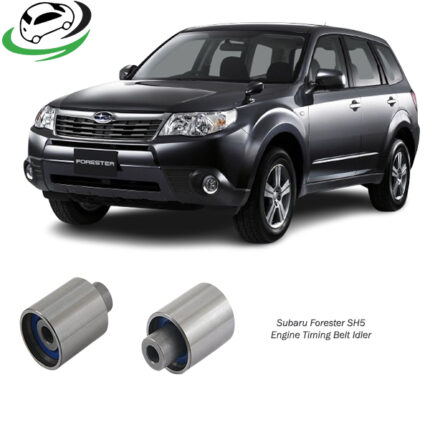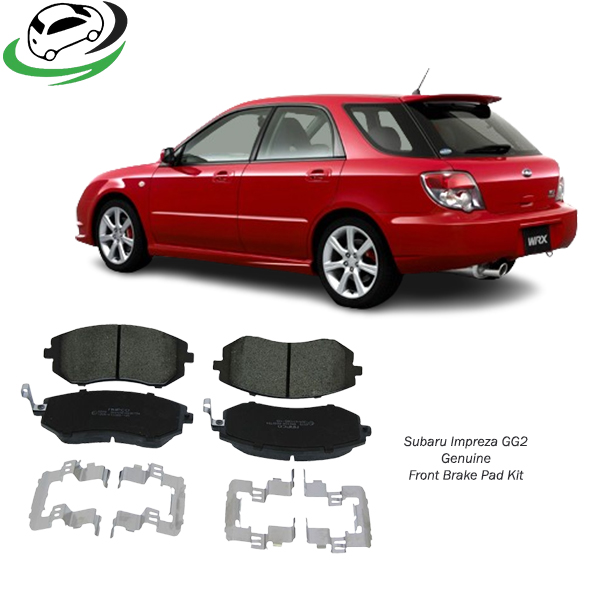-11%
Get Subaru Impreza GG2 Genuine Front Brake Pad Kit 26296SA032
A Genuine Front Brake Pad Kit is one of the most essential components in a vehicle’s braking system, designed to deliver optimal stopping power, reduce wear on other brake parts, and enhance driving safety. When choosing brake pads, genuine or original equipment manufacturer (OEM) pads often outperform aftermarket options in terms of fit, durability, and compatibility with specific vehicle models. Here’s a detailed overview of what genuine front brake pad kits offer, their advantages, how to recognize wear, and tips on installation and maintenance.
1. Function and Importance of Brake Pads
Brake pads play a crucial role in converting kinetic energy into thermal energy, ultimately stopping a vehicle. When the driver presses the brake pedal, hydraulic pressure forces the brake calipers to squeeze the pads against the brake rotors (discs). This action creates friction, slowing down and eventually stopping the vehicle. For this reason, the efficiency and quality of brake pads directly impact the braking system’s performance and, by extension, vehicle safety.
2. Components of a Genuine Front Brake Pad Kit
A typical front brake pad kit includes several key components:
- Brake Pads: The primary part responsible for creating friction. These pads are often constructed from materials like ceramic, semi-metallic, or organic compounds, each offering distinct performance characteristics.
- Shims: Metal plates attached to the back of brake pads that help reduce noise and vibration. High-quality kits usually include shims that match the design of the original equipment.
- Wear Sensors: Some kits come with wear sensors that signal when the pads need replacement.
- Lubricant: Kits may also include lubricant for specific areas of the brake system to ensure smooth operation and reduce squealing.
- Hardware: High-end kits often come with replacement hardware, including clips and springs, that hold the pads in place.
3. Benefits of Choosing Genuine Brake Pads
Opting for genuine brake pads offers several key advantages:
- Optimal Fit and Compatibility: OEM brake pads are manufactured to meet the specific standards of the vehicle’s make and model, ensuring a precise fit that aftermarket pads may lack. This compatibility reduces installation challenges and improves overall performance.
- Reliable Stopping Power: Genuine pads are rigorously tested to meet safety and performance standards, ensuring they deliver the right level of stopping power.
- Enhanced Durability: OEM brake pads are usually constructed from high-quality materials that are heat-resistant and wear-resistant. This durability translates to longer life and less frequent replacements, saving time and money over the long term.
- Noise Reduction: Because genuine pads are engineered specifically for the vehicle, they often come with noise-reducing features like fitted shims and optimal friction materials. This can lead to quieter operation compared to generic pads.
- Warranty Support: In many cases, genuine parts come with a warranty or guarantee, offering protection against manufacturing defects that aftermarket parts may lack.
4. Types of Materials Used in Brake Pads
Brake pads come in several materials, each with its own performance characteristics:
- Ceramic: Ceramic pads are quiet, produce less dust, and provide consistent braking power. They are often chosen for their longevity and smooth braking feel.
- Semi-Metallic: These pads contain metal fibers, making them more durable and effective in high-temperature conditions. However, they may generate more noise than ceramic pads.
- Organic (Non-Asbestos Organic – NAO): Organic pads are softer and quieter but tend to wear faster and produce more dust. They are often found in standard or economy brake pad kits.
- Low-Metallic NAO: These pads have a small amount of metal, offering a balance between organic and semi-metallic characteristics. They are quieter than semi-metallic pads and provide reliable stopping power but can produce more dust.
5. Signs Your Brake Pads Need Replacement
Knowing when to replace brake pads can help prevent rotor damage and other costly repairs. Common signs of worn brake pads include:
- Squealing or Squeaking Noises: High-pitched noises when braking may indicate that the pad material has worn down, and metal parts are coming into contact with the rotor.
- Reduced Braking Performance: If the vehicle takes longer to stop, this could be a sign that the pads are too thin to create sufficient friction.
- Vibration When Braking: Worn pads or warped rotors can cause the brake pedal or steering wheel to vibrate when braking.
- Dashboard Warning Light: Vehicles with wear sensors will display a warning light when the pads need replacing.
- Visual Inspection: If you can see the brake pads through the wheels, inspect them for thickness. Pads should be replaced if they are thinner than 3-4 mm.
6. Installation Process for Brake Pads
While brake pad installation is manageable for those with mechanical experience, a professional installation ensures safety and longevity. Here’s an outline of the typical process:
- Prepare the Vehicle: Place the vehicle on a jack and remove the wheels to access the brake system.
- Remove Old Pads: The caliper bolts are removed to slide out the old brake pads.
- Inspect and Clean Components: Check the rotor for damage and use brake cleaner to remove any dust or debris.
- Install New Pads and Hardware: Place the new pads into the caliper bracket and reassemble with the supplied hardware.
- Apply Lubricant: Use the supplied lubricant on the back of the pads or shims to reduce noise.
- Reassemble and Test: Reattach the wheels and take the vehicle for a test drive to ensure smooth braking.
7. Maintenance Tips for Brake Pads
To extend the life of your brake pads and keep your braking system in optimal condition, follow these maintenance tips:
- Avoid Hard Braking: Repeated hard braking generates heat and wears pads faster. Try to slow gradually when possible.
- Regularly Inspect Brake Components: During routine vehicle check-ups, have your brake system inspected to catch wear early.
- Flush Brake Fluid: Brake fluid should be changed every two to three years to maintain hydraulic pressure and prevent corrosion within the brake lines.
- Rotate Tires: Tire rotation ensures even wear across all wheels, balancing the braking load on each side.
8. Environmental and Safety Considerations
When choosing brake pads, consider the environmental impact. Some regions restrict the use of materials like copper in brake pads due to the potential for contamination in waterways. Genuine brake pads are often designed to meet these regulations, ensuring a safe choice for both the environment and your vehicle.
9. Conclusion: Why Invest in a Genuine Front Brake Pad Kit?
A genuine front brake pad kit is an investment in safety, reliability, and peace of mind. These kits offer exceptional stopping power, tailored fitment, and durability, reducing the need for frequent replacements. Additionally, OEM kits come with noise reduction features and high-quality materials that enhance both the performance and lifespan of your braking system.
By choosing genuine brake pads, you’re not only securing the reliability of your vehicle’s braking system but also ensuring your vehicle performs at its best under various driving conditions. Remember, the braking system is one of the most critical safety systems in any vehicle, and a genuine front brake pad kit provides the assurance that you’re choosing a component engineered specifically for your vehicle’s needs.
Follow us on Facebook for more parts.




Reviews
Clear filtersThere are no reviews yet.